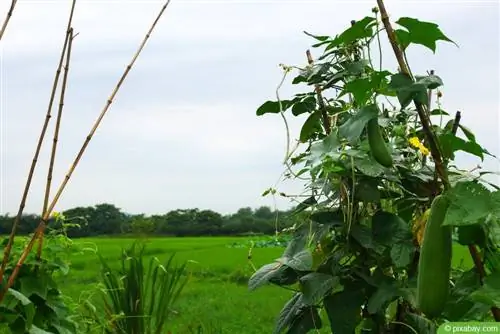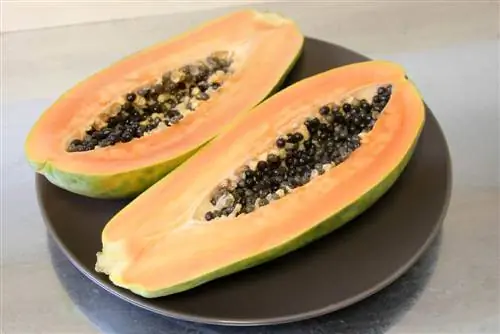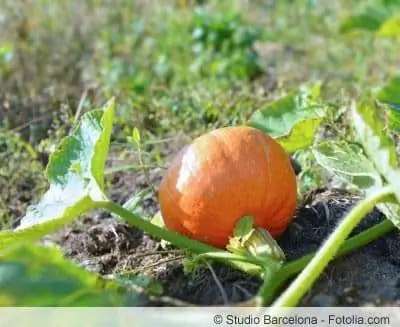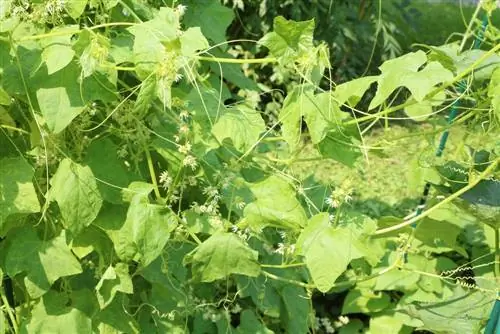- Author admin [email protected].
- Public 2023-12-17 03:39.
- Last modified 2025-01-24 12:45.
The real sponge gourd has the botanical name Luffa aegyptica or Luffa cylindrica, it is also known as sponge gourd and luffa cucumber. The plant is cultivated primarily for its fibrous tissue skeleton. However, the still young vegetables can also be used in the kitchen for dishes. A certain procedure must be followed when growing and caring for it; the following tips will ensure a successful harvest.
Location
The luffa cucumber belongs to the pumpkin family and comes from tropical countries; it is particularly widespread in Asia and Africa. That's why the sponge gourd doesn't cope well with the cold of the local latitudes. For this reason, exposed locations at mountainous altitudes are not at all suitable for cultivation. On the other hand, the sponge cucumber can be cultivated successfully in warmer wine-growing regions with the right care.
- Depends on warm location conditions
- Full sun and sheltered places are ideal
- Can be grown well in a greenhouse
- Alternatively, breeding in the winter garden is possible
- Needs humus and fertile soils
- Slightly acidic to neutral pH value is optimal
Note:
If you have enough space, you can also grow the loofah in a sufficiently large planter on a sheltered terrace or a non-drafty balcony.
Sowing & Propagation
Since the sponge pumpkin is used to warm conditions in its original home, it can only be planted in the local garden after the last ground frosts. If you sow too early, you risk the seeds not germinating. It is therefore advisable to sow Luffa aegyptica in pre-culture, either at room temperature in the living room or in the greenhouse or winter garden. To facilitate germination, it is helpful to lightly scratch the seed coat with a file. Alternatively, the seeds can be soaked for a day to speed up the germination process.
- Seeds germinate at around 20-25 °C
- Prefer plants from March to April
- Germination time of the seeds is 10-20 days
- Prick out after emergence
- Plant outdoors only after the Ice Saints
- From mid-May there will be no more night frosts
Watering & Fertilizing
Luffa cylindrica needs constant soil moisture to thrive and produce rich yields when harvested. However, a good sense of proportion is required when watering, as too few or too many watering units can lead to problems. By incorporating mulch, moisture in the soil can be retained for longer and the plant can be protected from damaging drought. In order for the sponge gourd to develop its magnificent fruits, the plant depends on careful fertilization measures. It should be noted that extremely nitrogen-containing nutrients inhibit flower growth, so that fruit development suffers.
- Always keep the sponge cucumber moist
- Regular rainfall is usually enough
- Additional watering during prolonged dry periods
- Fertilize every 4-6 weeks, don't overdo it
- Fertilizer containing potassium is ideal
- Blue grain and compost are suitable
Cutting
As a rule, cutting the loofah is not necessary. However, targeted pruning can support the growth of green and heavily furrowed berries.
- Cut after flowering
- Remove most wilted flower heads
- A few flowers remain on the plant
- Fruits then grow significantly larger
- Also cut off the first four side branches
- This improves growth
Flowering time, fruits & height
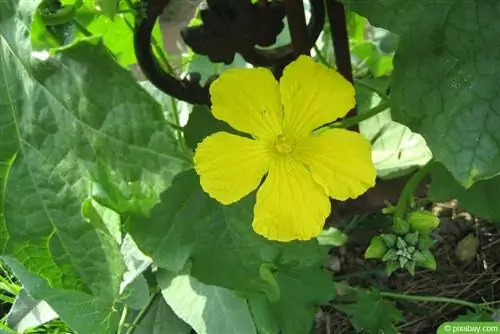
Luffa aegyptiaca is a lushly growing climbing plant whose tendrils can reach an astonishing length. The young sponge cucumbers are edible and contain a lot of vitamin C. Not only the cucumber-like fruits are suitable for preparing dishes, the flowers can also be eaten.
- Growth height is around 2.50 meters
- Trails grow up to 10-15 meters long
- Make sure there is enough space
- Flowering period from July to September
- Color of the flowers are yellow
- Flowers are a delicious decoration for salads
- Sponge gourds are cylindrical in shape
- Reach a length of 6 to 25 cm
- Diameter is between 2.5 to 6 cm
Wintering
Since the luffa cucumber is an annual climbing plant, no measures are required for overwintering.
Plants
Due to the lush growth, sufficient planting distance must be maintained so that the sponge cucumber can develop without restrictions. A stable growth aid is also important so that the plant has sufficient support. Both prostrate and ascending growth forms are possible, although the tall growing direction is more recommended. If the plant is given an appropriate location, it will quickly develop into an ornament in the garden. Some of the cucumber-like fruits take on enormous proportions and hang down in droves.
- Maintain a planting distance of around 50 to 60 cm
- Luffa cucumber needs a climbing frame as a climbing aid
- Tie up and tie the plant
- Alternatively let it grow over an arch
- Cultivation on strong fences is also possible
Harvest
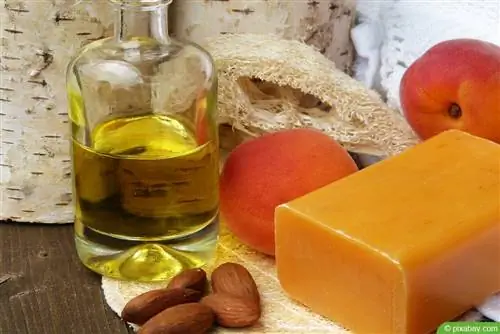
The impressive plant is mainly grown for the sponges that are extracted from the fruits. Ripe sponge cucumbers contain a dry and fibrous tissue that forms the basis for the loofah sponges. This white braid is hard and rough when dry, but softens in water. As the long cucumbers turn increasingly yellow toward the end of summer, the bright color indicates their advancing maturity. As soon as the shell begins to break under slight pressure, the fruit is ready to be harvested. The sponges are used in cosmetics and in bathing; they are primarily used for peeling. The practical fabric skeletons can also be used as scourers and for decoration.
- Harvest time from September to October
- Leave the fruits on the plant until the first frost
- Only then harvest and peel
- Cut ends generously
- Then soak in a water bath for several days
- Carefully remove pulp and seeds
- Press both out under running water
- At the end all that’s left is the scaffolding
- Dry in an airy and warm place for a few days
Note:
The fruits can also be eaten raw instead of traditional cucumbers; their taste is reminiscent of zucchini.
Diseases & Pests
Luffa aegyptiaca depends on extremely sunny locations, as the plant quickly becomes susceptible to diseases and pests in the shade. In addition, due to the lack of light and heat, only very small fruits develop on the sponge cucumber, so that the size of the sponges is quite manageable.
- Excessive watering leads to rot
- Shady and moist locations promote mildew
- Fight mildew fungus with milk-water mixture
- Use fresh milk in a ratio of 1:9
- Milk's own lecithins help with fungal diseases

